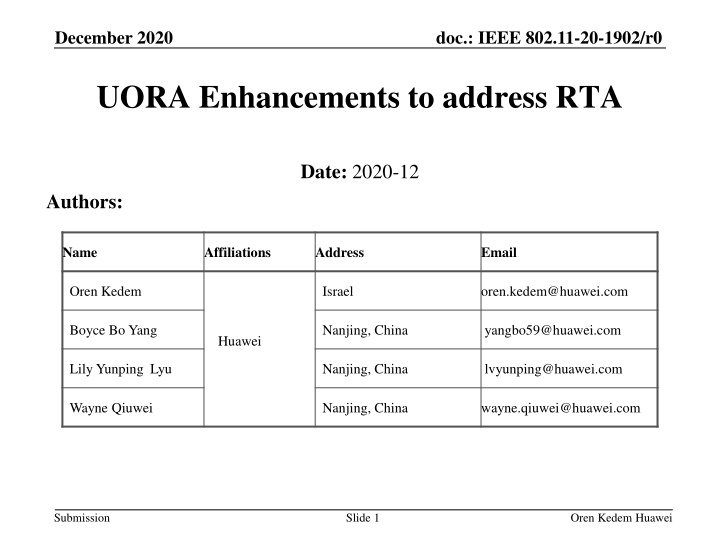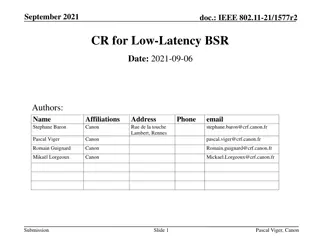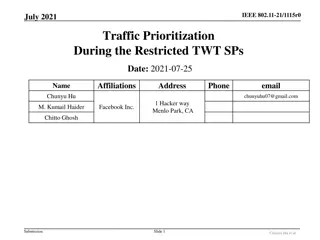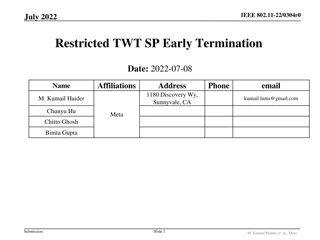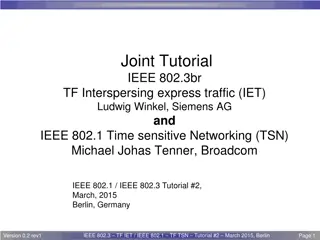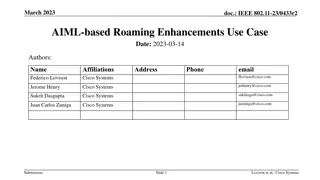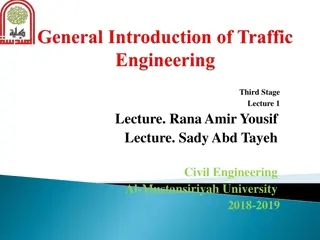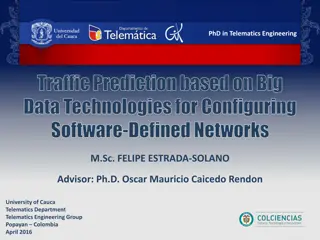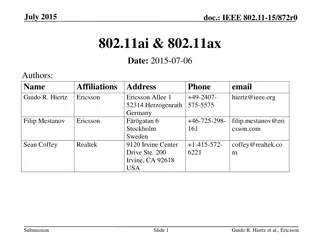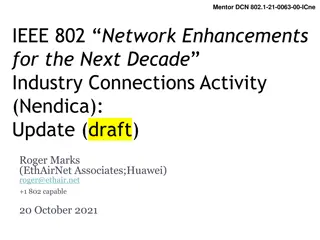Enhancements for Real-Time Application Traffic in IEEE 802.11-20-1902
This document discusses enhancements proposed to address non-periodic Real-Time Application (RTA) traffic characteristics in IEEE 802.11-20-1902 standard. The focus is on reducing latency, improving efficiency, and enabling continuous opportunity for transmissions in low-latency scenarios. Solutions related to UL/DL scheduling, TXOP initiation and ownership, and contention reduction for RTA STAs are presented.
Download Presentation

Please find below an Image/Link to download the presentation.
The content on the website is provided AS IS for your information and personal use only. It may not be sold, licensed, or shared on other websites without obtaining consent from the author.If you encounter any issues during the download, it is possible that the publisher has removed the file from their server.
You are allowed to download the files provided on this website for personal or commercial use, subject to the condition that they are used lawfully. All files are the property of their respective owners.
The content on the website is provided AS IS for your information and personal use only. It may not be sold, licensed, or shared on other websites without obtaining consent from the author.
E N D
Presentation Transcript
doc.: IEEE 802.11-20-1902/r0 December 2020 UORA Enhancements to address RTA Date: 2020-12 Authors: Name Affiliations Address Email Oren Kedem Israel oren.kedem@huawei.com Boyce Bo Yang Nanjing, China yangbo59@huawei.com Huawei Lily Yunping Lyu Nanjing, China lvyunping@huawei.com Wayne Qiuwei Nanjing, China wayne.qiuwei@huawei.com Submission Slide 1 Oren Kedem Huawei
doc.: IEEE 802.11-20-1902/r0 December 2020 Introduction 11be PAR is targeting to address Real Time Application (RTA) Targeted RTA (e.g. URLLC) require 1-10ms E2E latency [1]. RTA traffic is characterized also with non-periodic data (e.g. Human Safety, Sensors Alerts, Machine Control etc) . Current methods to send RTA non-periodic data are : EDCA Link access UL/DL Scheduling EDCA and Scheduling doesn t address RTA non-periodic traffic effectively and efficiently. Contribution proposes enhancements to address the above. Submission Slide 2 Oren Kedem Huawei
doc.: IEEE 802.11-20-1902/r0 December 2020 Impairments of UL/DL Scheduling Allocating Protected Service Periods for RTA traffic is useful in case traffic characteristics (i.e. arrival time) is known in advance. In case the RTA traffic is non-periodic and with non-anticipated time arrival, scheduling become very non efficient as many of the allocations might not being used by the allocated STA. APs scheduled Protected SP Latency LL Data Arrival time Sending RTA traffic in OFDMA UL transmission require sending BSR in advance and waiting for the UL allocation, hence it is time consuming and doesn t address the stringent RTA latency requirements. APs TXOP STA or APs TXOP Latency EHT TB PPDU Trigger EHT TB PPDU Trigger AP LL Data RA RU BSR EHT TB PPDU EHT TB PPDU STA Submission Slide 3 Oren Kedem Huawei
doc.: IEEE 802.11-20-1902/r0 December 2020 Enabling the RTA STA a Continues Opportunity Transmissions In case of low E2E Latency (1-2ms), STA must reduce Contention Awaiting time [2] and gain transmit opportunity immediately after data is in queue. However, if Wireless Medium is occupied, at least full TXOP should pass before RTA STA could contend the medium again. Low Latency is addressed only if RTA STA could be able to transmit its RTA data immediately when medium is free or busy. Submission Slide 4 Oren Kedem Huawei
doc.: IEEE 802.11-20-1902/r0 December 2020 TXOP Initiation and Ownership In EDCA TXOP operated by the STA, only the initiating STA is served hence is non-efficient and bad for RTA compared to AP TXOP where several STAs can be served. Nevertheless, EDCA STA TXOP cannot be totally avoided since: STA initiated TXOP is the only way STA can initiate transmission. AP cannot continuously hold the wireless medium with AP TXOPs Suggested Solution: TXOPs obtained by STAs should be granted to AP ownership. Granted TXOPs serve the initiating STA BSR as well as other STAs traffic. Submission Slide 5 Oren Kedem Huawei
doc.: IEEE 802.11-20-1902/r0 December 2020 MU RDG (11ax) RDG Protocol allow RDG responder AP to use HE MU PPDU and Trigger based UL PPDU with multiple STAs while including the RD initiator. TXOP AP Trigger HE MU PPDU BA HE Trigger- based PPDU BA SU PPDU STA1 HE Trigger- based PPDU Throughput gain at AP side (without reducing the initiator s bandwidth could be more then doubled. BA STA2 HE Trigger- based PPDU BA STA3 SIFS SIFS SIFS SIFS SIFS IEEE P802.11ax /D8.0 If the RD initiator is an HE STA and the RD responder is an HE AP, the RD response burst may contain one or more Basic Trigger frames. The Basic Trigger frames shall trigger the RD initiator and at least one other STA in a full bandwidth UL MU-MIMO transmission. An RD responder that transmits a Basic Trigger frame . and shall allocate a number of streams for the RD initiator that is not smaller than the number of streams of the RD initiator's last PPDU. The RD responder shall not transmit any PPDUs with a CH_BANDWIDTH that is wider than the CH_BANDWIDTH of the PPDU containing the frame(s) that delivered the RD grant. MU RDG can be used as the TXOP Granting mechanism Submission Slide 6 Oren Kedem Huawei
doc.: IEEE 802.11-20-1902/r0 December 2020 UORA Group Allocations 11ax UL OFDMA-based random access (UORA) allow multiple STAs to randomly access the medium in a joint TB PPDU transmission. UORA is effectively used when AP doesn t know all station BSR. In this case RA-RU is allocated for STAs to contend. However, 11ax UORA can be allocated only to all Associated or all Unassociated group STAs. UORA should provide a Group Allocation mechanism to prioritize RTA STAs. AP could use UORA Group Allocations in every its obtained/granted TXOP Submission Slide 7 Oren Kedem Huawei
doc.: IEEE 802.11-20-1902/r0 December 2020 UORA Mechanism (11ax) Under UORA, STA manages OBO random backoff counter on received RA-RU and transmit its data. Utilizing UORA reduce EDCA Contention Time. Submission Slide 8 Oren Kedem Huawei
doc.: IEEE 802.11-20-1902/r0 December 2020 Suggested EHT improvements for UORA Define Group-AID values intended for RA-RU allocated for RTA STA. RA-RU with Group-AID could be contended only by stations members of that group. HE UORA doesn t differentiate traffic types nor Access Categories. Allow Group-AID allocation to serve Access Categories (AC) as in EDCA Define different and dynamic EOCWmin and EOCWmax values for multiple ACs. Submission Slide 9 Oren Kedem Huawei
doc.: IEEE 802.11-20-1902/r0 December 2020 Enhanced UORA Allocating RA-RU Group AID STA3: Associated, AID=4, G-AID=2040 STA2: Associated, AID=3, G-AID=2040 Trigger frame 1 (Random Access) Trigger frame 2 (Random Access) EHT TB PPDU from STA1 RU 1 EHT TB PPDU from STA4 RU 1 AID 1 RU 1 AID 7 RU 1 STA5: Unassociated, AID=9 STA4: Associated, AID=7 STA1: Associated, AID=1 Frequency Frequency EHT TB PPDU from STA2 RU 2 G-AID 2040 RU 2 EHT TB PPDU from STA3 RU 2 G-AID 2040 RU 2 Multi-STA Block Ack Multi-STA Block Ack G-AID 2040 RU 3 AID 0 RU 3 EHT TB PPDU from STA3 RU 3 EHT TB PPDU from STA1 RU 4 AID 0 RU 4 AID 0 RU 4 AID 2045 RU 5 AID 2045 RU 5 EHT TB PPDU from STA5 RU 5 STA1 STA2 STA3 STA4 STA5 STA1 STA2 STA3 STA4 STA5 Initial OBO values Initial OBO values G-AID2040 OBO=1 AID0 OBO=3 G-AID2040 OBO=4 AID0 OBO=2 G-AID2040 OBO=3 AID0 OBO=3 G-AID2040 OBO=2 AID0 OBO=2 AID0 OBO=2 AID0 OBO=2 AID2045 OBO=1 AID0 OBO=2 AID0 OBO=3 AID2045 OBO=2 RU1 (AID 7) RU2 (G-AID 2040) RU3 (AID 0) RU4 (AID 0) RU5 (AID 2045) RU1 (AID 1) RU2 (G-AID 2040) RU3 (G-AID 2040) RU4 (AID 0) RU5 (AID 2045) Use this RU Use this RU G-AID2040 OBO 1 = 0 (Randomly TX random access RUs) G-AID2040 OBO 2 = 0 (Randomly pick random access RUs) G-AID2040 OBO - 2 = 1 AID0 OBO 2 = 0 (Randomly TX random access RUs) AID0 OBO 2 = 0 (Randomly TX random access RUs) AID0 OBO=2 AID0 OBO=3 AID0 OBO=2 AID0 OBO-1=2 AID2045 OBO-1=0 Use this RU AID2045 OBO-1=1 Resume OBO in next trigger frame Select new G-AID2040 OBO value Select new OBO value Select new OBO value Select new OBO value Select new OBO value AID0 OBO unchanged Resume OBO in next trigger frame Resume OBO in next trigger frame Resume OBO in next trigger frame QoS STA is getting served per allocated G-AID Note: In this example, STA has separate OBOs for each RA-RU type and group-AID Submission
doc.: IEEE 802.11-20-1902/r0 December 2020 Setup During Association and per QoS agreement, AP exchange with STA its requirements and the G-AIDs it is admitted to contend. AP Client A Client B Contending the Meidum via EDCA APs Transmit Opportunity Contending the Medium via UORA RA-RU G-AID=2040 Submission Slide 11 Oren Kedem Huawei
doc.: IEEE 802.11-20-1902/r0 December 2020 Performance with UORA Group-AID UORA is based on ALOHA with maximum efficiency of about 35% (1/e). Utilizing Group-AID allocations increase the number of RTA STA could be supported and improve performance in terms of both the probability of latency. [3] shows major performance improvements in case OFDMA UORA incorporates Group-AID allocations. 11ax based UORA Resource allocation Improved algorithm based on 11ax UORA unicast allocations UORA Resource allocation incorporating Group RA-RU Submission Slide 12 Oren Kedem Huawei
doc.: IEEE 802.11-20-1902/r0 December 2020 Conclusion EDCA Link access is the only method for STA to initiate traffic transmission. Performance are increased if STA TXOPs is granted to AP that utilize DL MU PPDU and Trigger Based UL MU PPDU. To meet RTA requirements and per network configuration, TXOPs obtained by STA should be granted to AP while initiator BSR request are being kept. 11ax UORA functionality could be enhanced for RTA by the following: Define Group AID values for RA-RU allocated for QoS stations, RA-RU with Group AID could be contended only for stations included in that group. Define the support for data transmission in all Access Categories. Define different set values of EOCWmin and EOCWmax to priorities various ACs. Submission Slide 13 Oren Kedem Huawei
doc.: IEEE 802.11-20-1902/r0 December 2020 Straw Poll 1 Do you agree that 11be SFD will include network configuration option in which STA obtained TXOP is granted to AP while keeping the RDG Initiator throughput performance ? Yes No Abstain Submission Slide 14 Oren Kedem Huawei
doc.: IEEE 802.11-20-1902/r0 December 2020 Straw Poll 2 Do you agree that 11be SFD will include UORA enhancements for RTA STA by allowing Group-AID allocations and supporting Access Categories ? Yes No Abstain Submission Slide 15 Oren Kedem Huawei
doc.: IEEE 802.11-20-1902/r0 December 2020 References [1] 11-19-1207-04-00be-Views on Latency and Jitter Features in TGbe [2] 11-19-0762-01-00be- Latency analysis for EHT [3] [IEEE Publications] Enabling Massive Real-Time Applications in TGbe Submission Slide 16 Oren Kedem Huawei
